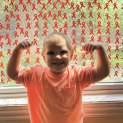Childhood Leukemia in Kenya Identified Through Malaria Slide Review

Background: Nearly 10 million children live in western Kenya, and based on the incidence of leukemia, 250 children would be expected to develop leukemia there each year. We believe many children are never diagnosed with leukemia because of the lack of proper diagnostic testing, and die without ever having a chance to receive curative therapy. Project Goal: In this study, we propose to increase the case detection rate of leukemia by utilizing a simple, widely available, and standard procedure for diagnosing malaria.
Project Update: (Feb. 2013)
Our epidemiology project in Kenya, funded by ALSF, to identify cases of leukemia, has been running for 8 months now. We have been collecting slides of blood, stained to detect malaria, in children for about 4 months so far. When I traveled to Eldoret, Kenya to participate in a childhood cancer conference in January, I met with our technician training him to read those malaria slides for the possible presence of leukemia. Already in reviewing just the first 3000 slides (of our planned 30,000) we have 5 cases that are highly suspicious for leukemia. The results are more striking than I had imagined. We are in the process of confirming those cases and will be collecting more cases in the coming year.
The project is already developing some "side effects". The lab staff of the small district hospital in which we are based is already learning how to detect leukemia on their own by examining slides in real time. On our team's last visit, one of our Co-investigators, Dr. Skiles, was asked to see a young girl with low blood counts in the hospital ward. The girl had signs of leukemia which were confirmed on her blood counts. Dr. Skiles bundled her and her mother up in the study vehicle they had used for the visit and brought her back to Eldoret, about 50 miles away. They completed diagnostic workup and began treatment for her leukemia! This is exactly the type of patient, we proposed in our study, who is lingering in a local hospital and eventually dying without a diagnosis. The ALSF funds are allowing us to teach the Kenyans that leukemia exists and can be diagnosed and treated early, making a difference in these children's lives."
Project Update: (July 2015)
Our project to improve the case detection rate of leukemia in children in Kenya is progressing well. We had a slow start to order all our slides and begin the collection process in our district hospital. We started our major slide collection in October 2012, and since we were projecting 12-18 months of slide collections, we easily met our target range to complete our project. We have already identified nearly 50 potential leukemia cases in the first 26,000 slides examined. We hope to confirm the presence of leukemia by molecular techniques and individual case tracking in the hospitals during the remainder of our contract extension this year. Leukemia is clearly prevalent in Kenya. The problem is one of not recognizing that it is there. Our project is one step in educating the doctors, nurses, lab personnel and population that leukemia exists and can be treated successfully.

